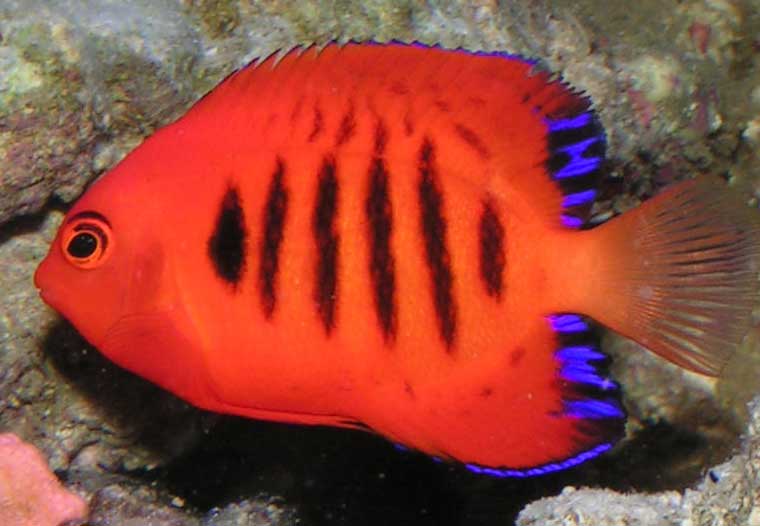
Centropyge loriculus
Superregnum : Eukaryota
Supergroup: Unikonta
Cladus: Opisthokonta
Cladus: Holozoa
Regnum: Animalia
Subregnum: Eumetazoa
Cladus: Bilateria
Cladus: Nephrozoa
Superphylum: Deuterostomia
Phylum: Chordata
Subphylum: Vertebrata
Infraphylum: Gnathostomata
Megaclassis: Osteichthyes
Superclassis/Classis: Actinopterygii
Classis/Subclassis: Actinopteri
Subclassis/Infraclassis: Neopterygii
Infraclassis: Teleostei
Megacohors: Osteoglossocephalai
Supercohors: Clupeocephala
Cohors: Euteleosteomorpha
Subcohors: Neoteleostei
Infracohors: Eurypterygia
Sectio: Ctenosquamata
Subsectio: Acanthomorphata
Divisio/Superordo: Acanthopterygii
Subdivisio: Percomorphaceae
Series: Eupercaria
Ordo: Perciformes
Subordo: Percoidei
Superfamilia: Percoidea
Familia: Pomacanthidae
Genus: Centropyge
Species: Centropyge loriculus
Name
Centropyge loriculus (Günther, 1874)
Original combination: Holacanthus loriculus Günther, 1874
Synonyms
Centropyge flammeus Woods & Schultz in Schultz et al., 1953
References
Schindler, I. & Schneidewind, F. 2004. Revision of Centropyge fisheri (Snyder, 1904) (Teleostei, Pomacanthidae). Zeitschrift für Fischkunde 7(1): 31–42. PDF.
Schultz, L.P., Herald, E.S., Lachner, E.A., Welander, A.D. & Woods, L.P. 1953. Fishes of the Marshall and Marianas islands. Vol. I. Families from Asymmetrontidae through Siganidae. Bulletin of the United States National Museum 202(1): i–xxxii + 1–685, Pls. 1–74. BHL Reference page.
Vernacular names
English: Flame angelfish
magyar: Lángvörös császárhal
The flame angelfish (Centropyge loricula)[3] is a marine angelfish of the family Pomacanthidae found in tropical waters of the Pacific Ocean.[3] Other common names include flame angel, flaming angelfish and Japanese pygmy angelfish.[1]
Description
The flame angelfish's coloration is bright orange-red with a vertical elongated black spot and four or five bars on the sides, the posterior part of the dorsal, and anal fins, with alternating short purple-blue and black bands.[3] Specimens from the Marquesas lack the vertical black bars.[1] Males are generally larger and slightly more colored than females.
The life span of the flame angelfish is 5–7 years or more.[4]
Range
It is found in various reefs of Oceania, most common in Marshall, Line and Cook Islands. The fish is also, although less commonly, found in the Hawaiian Islands. Particularly, the flame angelfish can be found on the foreslope of coral reefs and clear lagoons.[1]
Diet
In the wild, the flame angelfish has a varied diet consisting of algae and crustaceans. There are occasional specimens that live very long lives in reef aquaria, but the majority of these fish will often die for no apparent reason when they are older. This may be easily explained as many of the Centropyge family are predominantly plankton eaters as juveniles and will switch to consuming its natural adult diet once fully grown. Sometimes, all it takes is for an underfed individual to "test" a food source. This being the case, angelfish are usually added to a well established tank and fed frozen mysis shrimp or meaty crustaceans such as shrimp and clam.
In aquarium
In captivity, this species feeds on a variety of food including brine shrimp, mysis shrimp, and other meat as well as spirulina, seaweed sheets, and pellets, also from personal experience they favor tuna and table shrimp.[3]
The flame angelfish is known to be shy upon introduction to an established aquarium,[3] especially smaller specimens; but, within a week, it will gain confidence and is then constantly seen grazing around live rock during the day.
The flame angelfish is often considered reef safe. They will adapt to a captive diet quickly which will usually prevent them from consuming soft or stony corals. Individual specimens that do pick at coral or clam mantles are more often than not under fed or under nourished.
Breeding
The flame angelfish has been known to spawn in captivity, with successfully captive bred specimens offered by Atoll Farm Aquaculture in Thailand.[5] The flame angelfish is haremic in the wild and can be kept in pairs or trios in an extra-large aquarium. The aquarium should contain only one male — the males have more blue on the outer edge of the dorsal and anal fins, and tend to be larger. The fish will spawn toward the end of the day and release pelagic gametes into the water column. Collecting the eggs and raising the larvae is the biggest challenge. The flame Angelfish are broadcast spawners, releasing eggs and sperm simultaneously at dusk. They rise into the water column and release their eggs and sperm at the top.
References
Allen, G.; Fricke, R.; Pyle, R.; Myers, R. (2010). "Centropyge loricula". IUCN Red List of Threatened Species. 2010: e.T155308A4771656. doi:10.2305/IUCN.UK.2010-4.RLTS.T155308A4771656.en. Retrieved 19 November 2021.
Froese, Rainer; Pauly, Daniel (eds.) (2019). "Centropyge loricula" in FishBase. December 2019 version.
"Animal Planet :: Fish Guide -- Angelfish, Dwarf". Animal Planet. Retrieved 2012-08-09.
"Flame Angel fish - Centropyge loricula". Fishlore. Retrieved 21 Sep 2012.
"Thailand's Atoll Farm Latest To Successfully Breed Pygmy Angelfish". Reef Builders. Retrieved 18 May 2019.
Retrieved from "http://en.wikipedia.org/"
All text is available under the terms of the GNU Free Documentation License

